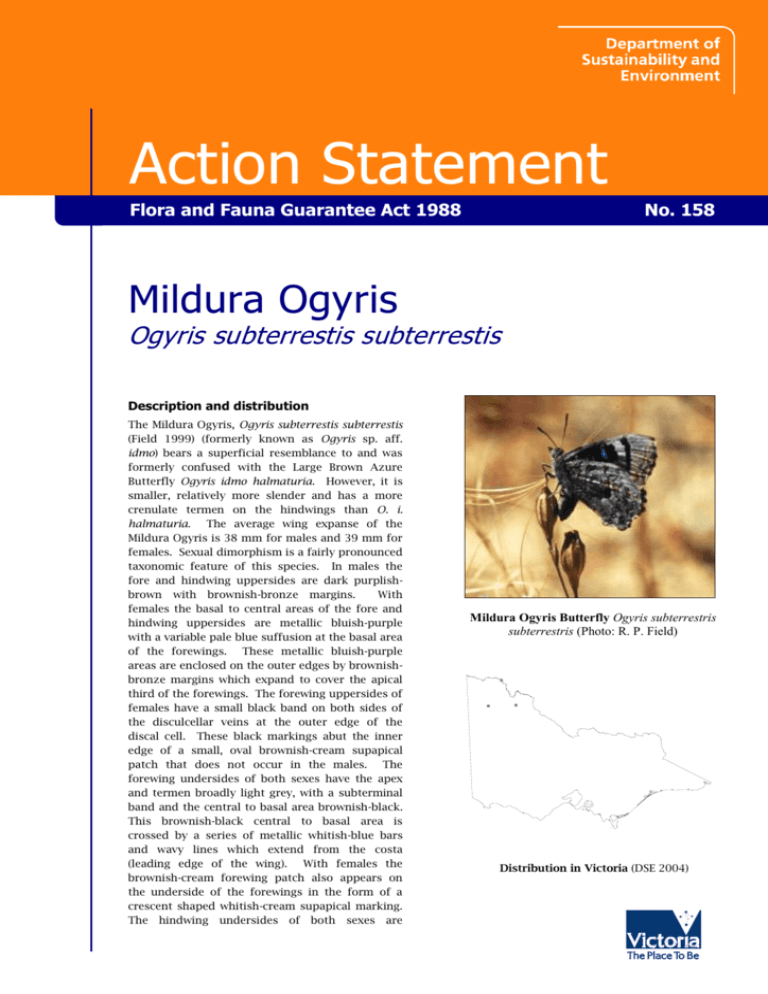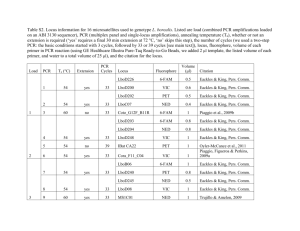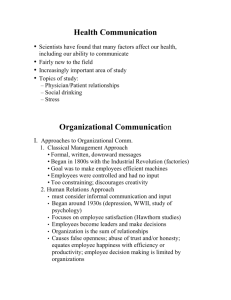This is to thank - Department of Environment, Land, Water and
advertisement

Action Statement Flora and Fauna Guarantee Act 1988 No. 158 Mildura Ogyris Ogyris subterrestis subterrestis Description and distribution The Mildura Ogyris, Ogyris subterrestis subterrestis (Field 1999) (formerly known as Ogyris sp. aff. idmo) bears a superficial resemblance to and was formerly confused with the Large Brown Azure Butterfly Ogyris idmo halmaturia. However, it is smaller, relatively more slender and has a more crenulate termen on the hindwings than O. i. halmaturia. The average wing expanse of the Mildura Ogyris is 38 mm for males and 39 mm for females. Sexual dimorphism is a fairly pronounced taxonomic feature of this species. In males the fore and hindwing uppersides are dark purplishbrown with brownish-bronze margins. With females the basal to central areas of the fore and hindwing uppersides are metallic bluish-purple with a variable pale blue suffusion at the basal area of the forewings. These metallic bluish-purple areas are enclosed on the outer edges by brownishbronze margins which expand to cover the apical third of the forewings. The forewing uppersides of females have a small black band on both sides of the disculcellar veins at the outer edge of the discal cell. These black markings abut the inner edge of a small, oval brownish-cream supapical patch that does not occur in the males. The forewing undersides of both sexes have the apex and termen broadly light grey, with a subterminal band and the central to basal area brownish-black. This brownish-black central to basal area is crossed by a series of metallic whitish-blue bars and wavy lines which extend from the costa (leading edge of the wing). With females the brownish-cream forewing patch also appears on the underside of the forewings in the form of a crescent shaped whitish-cream supapical marking. The hindwing undersides of both sexes are Mildura Ogyris Butterfly Ogyris subterrestris subterrestris (Photo: R. P. Field) Distribution in Victoria (DSE 2004) cryptically coloured in shades of light grey, brownish-grey and brownish-black, in a succession of irregular wavy lines and bands. The healthiest population of Ogyris subterrestis occurs within and north of Hattah-Kulkyne National Park in low Moonah Melaleuca lanceolata woodland where it was discovered in 2000. Within Victoria, the species was previously recorded at the Mildura cemetery in October 1972. A small population was found by Vardy in remnant habitat at the western end of the cemetery (seven specimens were collected). In April 1975, one specimen was collected, and several butterflies observed by McCubbin at Lake Roulton (within the former Pink Lakes State Park) in the Murray-Sunset National Park (Quick pers. comm.). Butterflies were also recorded at this site, in open mallee, in 1996 (two specimens in February/April, and 15 in mid October)(Field pers. comm.). Field (pers. comm.) considered the Mildura Ogyris to be very abundant at this site in 1996. Outside of Victoria, two extant populations are known at Lake Douglas near Kalgoorlie in Western Australia (1993) and near Ramco in South Australia. A single female specimen which is lodged at the Australian National Insect Collection was collected from Calperum Station north of Renmark (SA) in 1998 (Douglas pers. comm.). Field (pers. comm.) notes there is a specimen in the South Australian Museum which was collected from the radiator of a car at Loxton, South Australia in 1986. There is also another old specimen collected from near Ceduna. The National Museum of Victoria also has a specimen collected in December 1912 by Lower from Broken Hill in New South Wales, which appears to be the Mildura Ogyris. The exact location of this site is not known (Field pers. comm.). Life history and ecology The Mildura Ogyris is probably bivoltine (has two generations per year), as adults at the Ramco site in South Australia are mainly on the wing during October/November and again in February/March (Moore pers. comm.). At Kalgoorlie in Western Australia, adults have been recorded from August till May (Field pers. comm.) In Victoria, most butterflies have been recorded in October, although a few in February and April (Field pers. comm.). At Ramco, males have been observed flying rapidly around or through open places in or near the breeding colony, usually within 2 metres of the ground and sometimes landing with closed wing on the outer foliage of bushes or low growing plants. Females appear to be more sedentary and spend long periods of time probing with their abdomens for oviposition sites around the entrances of Camponotus ant nests. At Pink Lakes, Field (pers. comm.) notes that females appear to stay within mallee vegetation, while males fly over open grassland areas. Ant Association It seems that the Mildura Ogyris is associated with Camponotus terebrans, a sugar ant (Field pers. comm.). Observations made by Moore and Field would appear to indicate that this butterfly is solely ant attended and that its larvae are either fed by adult ants or most probably are predacious on ant larvae. This conclusion was reached as a result of strong circumstantial evidence which suggests that both the larval and pupal stages of the life cycle of this species are completed underground within the nests of its attendant Camponotus ants. The wings of the butterflies often appear greasy, which is a further indication that the larvae feed on ant larvae. All other lycaenid butterflies which appear greasy are known to be predacious (Field pers. comm.). There is a high correlation between the distribution of Camponotus terebrans and Ogyris subterrestis subterrestis, O. idmo and O. otanes (Field pers. comm.). Camponotus terebrans is a widespread, common, species, which can be locally abundant (Field pers. comm.). Nests are always found in sandy areas, and colonies can be formed with between 10 and 15 entrances around a tree trunk, providing an obvious visual presence (Field pers. comm.). At Ramco, the most favoured nests seemed to be those that were situated against the lignotubers of mallee eucalypts (belonging to at least three species), where closer inspection revealed batches of up to 40 flattened spherical, brownish-grey eggs attached to the bark just inside or near the nest entrances. In Victoria, the exact breeding sites at Pink Lakes have not yet been found. There is abundant mallee vegetation and nests may be widely dispersed (Field pers. comm.). Douglas (1995) suggests that the ants may require a floristically diverse mallee habitat in which to attain a population level which can support a breeding colony of the Mildura Ogyris. However, Field (pers. comm.) suggests further work is required on the specific habitat requirements of the species. For example, the first specimen recorded in South Australia was found in a backyard; ant nests were found under the garage, and little mallee vegetation was present (Field pers. comm.). Field (pers. comm.) has also observed ant nests under headstones in the Mildura cemetery, as well as under Black Box Eucalyptus largiflorens, trees, mallee eucalypts and logs. At Ramco, Field (pers. comm.) observed ant nests at the base of a 2 line of planted eucalypts indigenous to the area. which were not would have been flying, which was adjacent to the breeding area. He considers the ants to be quite abundant in the cemetery and surrounding area (eg. the Sandalong Park Recreation Reserve). Douglas (1995) regarded the species as ‘Endangered’ in Victoria and Australia. The Mildura Ogyris has been listed as a threatened taxon under the Flora and Fauna Guarantee Act 1988. The population at Lake Douglas in Western Australia, which can experience disturbance by humans and vehicles, appears to have declined since 1991 (Field 1997). The numerous tracks and recreational activity cause soil compaction, which would be a threat to the attendant ants (Field pers. comm.). The population near Ramco in South Australia occurs along a small roadside strip of mallee (approximately 500 x 10m), and is potentially threatened by surrounding pesticide usage (Field 1997) and physical disturbance (Field pers. comm.). Conservation Status In its final recommendation the Scientific Advisory Committee (1998) has determined that the Mildura Ogyris is very rare in terms of abundance and distribution. Decline and threats It is highly likely that the Mildura Ogyris has always been a very rare species in Victoria, with an extremely restricted distribution and localised occurrences. Only two populations are currently known in Victoria, at and north of Hattah-Kulkyne National Park and west of Ouyen, near Pink Lakes. The Hattah population was abundant in spring 2000, and during the spring of 1996, the butterfly appeared to be abundant at the Pink Lakes site. On two other occasions, only one butterfly was seen at Pink Lakes (Field pers. comm.). The population previously known from the western end of the Mildura Cemetery appears to have died out as a result of habitat disturbance and possible flooding during 1974. The cemetery has been searched a number of times and the butterfly does not appear to be present. Disturbance Disturbances such as complete land clearing are likely to be detrimental to the butterfly, by removing mallee vegetation which may provide a source of food for the associated ant species, as well as potential nest sites. However, some forms of soil disturbance which expose significant areas of soil may be beneficial to the ants. McArthur et al. (1997) note that Camponotus terebrans is one of the first ant species to colonise disturbed sites. The apparent fate of the population at the Mildura Cemetery seems to indicate that this species may be sensitive to partial clearing and/or flooding of an area that is occupied by a breeding colony. Prolonged periods of flooding could represent a threat to the species, by drowning the larvae while underground (Field pers. comm.). Douglas (1995) notes that earthworks and soil removal from the Mildura Cemetery appear to have destroyed the population of the butterfly as well as reduced the number of Camponotus ant nests. However, Field (pers. comm.) notes that this soil disturbance may not have been a significant threat, having occurred in an area where the butterflies Observations made at Ramco in South Australia by the author, seemed to indicate that even a moderate stocking of sheep may cause this species to vacate a breeding area. Of approximately 60 mallee eucalypts that are inside a paddock which abuts the main breeding site, only one was found to be sheltering an ant nest, with a few Mildura Ogyris eggs at its entrance. The situation on the adjacent roadside verge to which sheep do not have access was very different; about 50% of the mallees had attendant ant nests at their bases, nearly all of which had clearly visible Mildura Ogyris egg batches at or near their entrances. While fires which occur at an inappropriate time of the year (ie. when adults are flying) could clearly represent a threat, fires at other times (ie. when larvae are underground) may not be detrimental. An appropriate fire regime may in fact benefit the butterfly. Camponotus terebrans can quickly recolonise burn areas and become dominant (Field pers. comm.). Wider conservation issues The Mildura Ogyris belongs to a small species complex within the genus Ogyris, which includes Ogyris otanes and the two Ogyris idmo subspecies. This species complex represents a unique element in the Australian butterfly fauna. From an evolutionary viewpoint the biology and life-history of this taxon and the two Ogyris idmo subspecies, which form the greater part of this species complex, are especially interesting; their larvae appear to be totally dependant on ants for their food supply and seem to be without a larval host plant (Field 1992). A Public Authority Management Agreement has been signed under the Flora and Fauna Guarantee Act 1988 for a small part of the Mildura cemetery, to ensure suitable management for the endangered plant Long Tails, Ptilotus polystachyus polystachyus. 3 A number of threatened species have been recorded within the Pink Lakes area. Most recent records for threatened fauna include the Barking Owl Ninox connivens (e), Major Mitchell’s Cockatoo Cacatua leadbeateri (v), Mallee Emu-wren Stipiturus mallee (Vv), Apostlebird Struthidea cinerea (v) and Bandy Bandy Vermicella annulata (Lower Risk – near threatened) (DSE 2003a). Twenty-one species of threatened flora have been recorded from the general area, including Small Nut-heads Haegiela tatei (Kv), Fleshy Minuria Kippistia suaedifolia (v), and Woolly Yellow-heads Trichanthodium skirrophorum (v) (DSE 2003b). Threatened species found near the Hattah-Kulkyne National Park site include the Regent Parrot Polytelis anthopeplus anthopeplus (Vv), Malleefowl Leipoa ocellata (E), Purple Love-grass Eragrostis lacunaria (v) Pin Sida Sida fibulifera (v) and Knotted Poa Poa drummondiana (r). Any management activities related to the protection of the Mildura Ogyris should take into consideration the possible impacts to other threatened species in the areas. Previous Management Action The late Frank Noelker and the author carried out preliminary survey work for extant populations of the Mildura Ogyris in far northwestern Victoria during March 1994. Despite careful searches at several localities no occurrences of this taxon were located. However, a small population of ants that appeared to be Camponotus terebrans were discovered in the Hattah-Kulkyne National Park 15km north of the Park Information Centre on the 31st March 1994. The Mildura Cemetery Reserve has been surveyed on a number of occasions for the presence of the butterfly and its attendant ant species. While the Pink Lakes area had been visited a number of times, a detailed survey was undertaken in 1996, when the butterfly was once again observed (Field pers. comm.). Part 2 (Family Lycaenidae) of the Australian Nature Conservation Agency commissioned recovery plan for threatened diurnal Lepidoptera in north-western Victoria has been completed by the author (Douglas 1995). This recovery plan details conservation strategies for thirteen nationally and/or regionally threatened lycaenid butterflies and includes the Mildura Ogyris. Recommendations are made under Action 3 of this report for future surveys which will probably need to be conducted during consecutive years to determine if additional Victorian populations of this species still exist. Noelker and the author implemented the first of these surveys during February and March 1995. The Department of Sustainability and Environment (DSE) has funding for this survey work. provided the Recommendations were also made under Action 2 of this recovery plan for rehabilitation of the site that was formerly occupied by this species at the western end of the Mildura Cemetery, so that a future attempt can be made at re-establishing a breeding population at the locality. The area at the western end had soil removed from it at some time in the past and has been illegally used by trail bike riders. The rehabilitation of this site has largely been completed. Conservation Objectives Long term objective To ensure that the Mildura Ogyris can survive, flourish and retain its potential for evolutionary development in the wild. Objectives of this Action Statement 1. To determine accurately the distribution and abundance of the Mildura Ogyris. 2. To protect and enhance its habitat at known sites. 3. To increase public awareness of the Mildura Ogyris. Intended Management Action The intended management actions listed below are further elaborated in DSE’s Actions for Biodiversity Conservation database. Detailed information about the actions and locations, including priorities, is held in this system and will be provided annually to land managers and other authorities. Survey and Monitoring 1. Survey for the Mildura Ogyris and/or Campanotus terebrans, preferably during October/November and February/March in the following areas of north west Victoria: Murray-Sunset National Park (including the former Pink Lakes State Park). Hattah-Kulkyne National Park (especially its northern and eastern boundaries). Mildura/Red Cliffs area (particularly in remaining areas of natural habitat). Responsibility: Region 2. Parks Victoria, DSE NW Monitor the Mildura cemetery annually to determine the abundance of Camponotus terebrans, taking into consideration the potential for future reintroduction of the butterfly. 4 Responsibility: DSE NW Region Responsibility: Habitat Protection and Rehabilitation - Mildura Cemetery 3. Protect remnant vegetation at both the eastern and western ends of Mildura Cemetery to prevent further habitat degradation (Cemetery Trust/DSE-LV). Responsibility: DSE Cemetery Trust 4. Region, Mildura Erect appropriate signs at the site and fence the area off in such a way as to discourage any illegal off-road trail bike or vehicular activity should this activity recommence. Responsibility: DSE Cemetery Trust 5. NW NW Region, Mildura Complete habitat rehabilitation activities which are likely to benefit Camponotus terebrans, and thus in turn maximise the chances of successfully reintroducing the butterfly. Revegetation with appropriate native species local to the area, including mallee eucalypts would be beneficial. Provision of fallen timber, old fence posts and/or the lignotubers of dead mallees could also be valuable. Responsibility: DSE Cemetery Trust NW Region, Mildura 6. Continue to liaise with the Mildura Cemetery Trust to apply a Public Authority Management Agreement. 7. Incorporate actions to protect, enhance and restore Mildura Ogyris and/or Campanotus terebrans habitat into Mallee Regional Catchment Strategy or its subordinate strategies via Biodiversity Action Plans. Implement these actions, according to priority, as resources become available, in conjunction with other agencies, community groups and landholders. Responsibility: Responsibility: 8. DSE NW Region DSE NW Region Incorporate information on the locations and management requirements of Mildura Ogyris and/or Campanotus terebrans into local planning schemes and overlays. Ensure that sites are protected in planning decisions and in the course of other Council activities. Responsibility: Rural City of Mildura Council Education 9. Increase community awareness by the production of a colour poster that illustrates specimens of the Mildura Ogyris, its attendant ant and the mallee and/or woodland habitats where these two species could possibly occur. DSE NW Region 10. Treat any sightings reported by the public as confidential, and investigate credible records. Responsibility: DSE NW Region 11. Train relevant DSE and PV staff (in areas where the butterfly may occur) in the identification of the butterfly and when it is likely to be present. Responsibility: Victoria DSE NW Region, Parks 12. Contact relevant land managers in the Pink Lakes area, Hattah-Kulkyne National Park and the Mildura Cemetery to ensure they are aware of the presence of, or previous presence of, the butterfly at these sites. Management of the Pink Lakes and Hattah-Kulkyne National Park areas should be appropriate for the conservation of the butterfly and its associated ant. Responsibility: DSE NW Region Research 13. Facilitate further research on the biology and life cycle of the Mildura Ogyris to improve knowledge of habitat requirements and ecological interactions with other species. Such research would be valuable prior to attempting any reintroduction programs. Encourage students to undertake relevant research as appropriate. Responsibility: DSE NW Region Liaison 14. Liaise with the South Australian Department of Environment and Natural Resources with the aim of establishing and coordinating a conservation group for the species complex to which Mildura Ogyris belongs. Responsibility: DSE NW Region Reintroduction 15. Assess the need for reintroduction of the Mildura Ogyris at the Mildura Cemetery in the near future. (The best technique for doing this would probably be to attach egg batches to solid objects at or just inside the entrances of the Camponotus ant nests. Eggs may be obtained from either the Ramco or probably more preferably from the Pink Lakes population. It may be most appropriate to wait until further research on the ecology of the butterfly and further surveys have been carried out, before undertaking a reintroduction program.) Responsibility: DSE NW Region 5 References Douglas, F. (1995) Recovery Plan for Threatened Diurnal Lepidoptera in North-Western Victoria, Part 1: Family Lycaenidae. Department of Conservation and Natural Resources: Melbourne. DSE (2003a) Advisory List of threatened vertebrate fauna in Victoria - 2003. Department of Sustainability & Environment. Biodiversity & Natural Resources Division: Melbourne. DSE (2003b) Advisory List of Rare or Threatened Plants in Victoria – 2003. Department of Sustainability & Environment. Biodiversity & Natural Resources Division: Melbourne DSE (2004) Atlas of Victorian Wildlife (electronic fauna database). Department of Sustainability & Environment. Biodiversity & Natural Resources Division: Melbourne. Field, R. P. (1992) Research Grant Report: Report to the Executive of the Australian Entomological Society on the Life History Studies and Species Determination of the Ogyris idmo Hewitson (Lepidoptera: Lycaenidae) complex in Western Australia, funded by AES Research Grant. Myrmecia 28(4):12-17. -------------- (1997) The Ogyris idmo Hewitson complex (Lepidoptera: Lycaenidae) as flagship species for conservation in southern Australia. Memoirs of the Museum of Victoria 56 (2): 389392. -------------- (1999) A new species of Ogyris Angas (Lepidoptera: Lycenidae) from southern arid Australia. Mem. Mus. Vict. 57: 251-259. Compiled by Fabian Douglas, consultant entomologist. Further information can be obtained from Department of Sustainability and Environment Customer Service Centre on 136 186. Flora and Fauna Guarantee Action Statements are available from the Department of Sustainability and Environment website: http://www.dse.vic.gov.au This Action Statement has been prepared under section 19 of the Flora and Fauna Guarantee Act 1988 under delegation from Professor Lyndsay Neilson, Secretary, Department of Sustainability and Environment, September 2003. © The State of Victoria, Department of Sustainability and Environment, 2003 Published by the Department of Sustainability and Environment, Victoria. 8 Nicholson Street, East Melbourne, Victoria 3002 Australia This publication may be of assistance to you but the State of Victoria and its employees do not guarantee that the publication is without flaw of any kind or is wholly appropriate for your particular purposes and therefore disclaims all liability for any error, loss or other consequence which may arise from you relying on any information in this publication. ISSN 1448-9902 McArthur, A. J., Adams, M. & Shattuck, S. O. (1997) A morphological and molecular review of Camponotus terebrans (Lowne) (Hymenoptera: Formicidae). Australian Journal of Zoology 45: 579-598. NRE (1996) Mallee Parks management plan. Department of Natural Resources and Environment, East Melbourne. SAC (1998) Final recommendation on a nomination for listing. Ogyris sp. aff. idmo – Ogyris butterfly (Nomination No. 389). Scientific Advisory Committee, Flora and Fauna Guarantee. Department of Natural Resources & Environment: Melbourne. Relevant web sites Image of the species (South Australia) http://users.chariot.net.au/~rbg/subterrestris.htm Victorian images (species, habitat, etc) http://www.museum.vic.gov.au/bioinformatics/but ter/images/comsubtlive.htm 6






